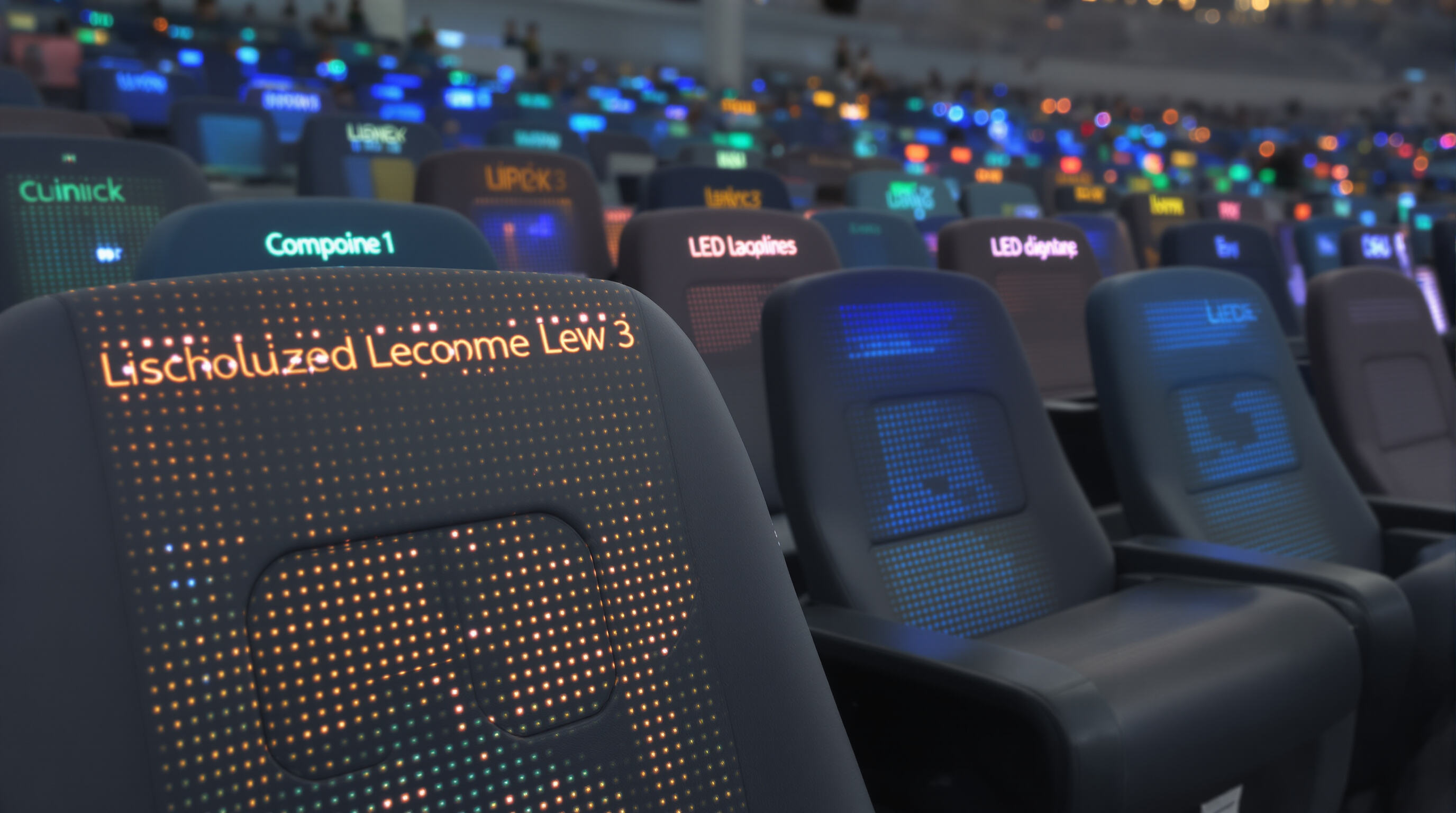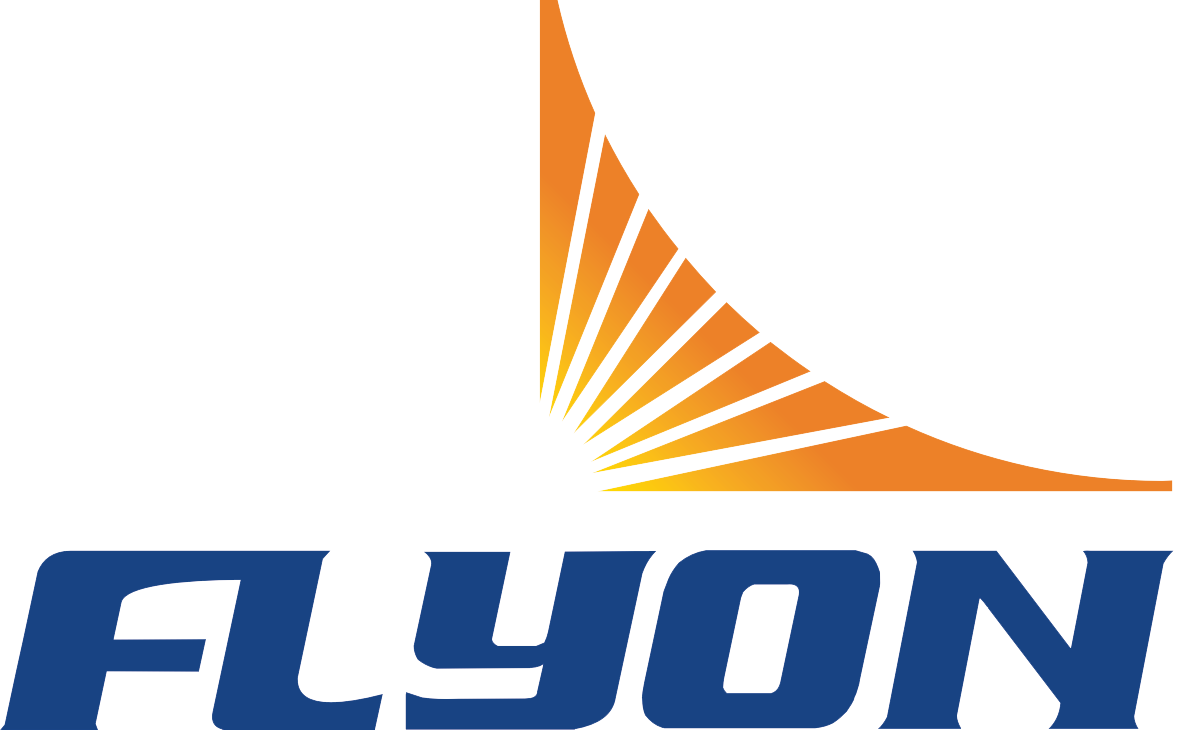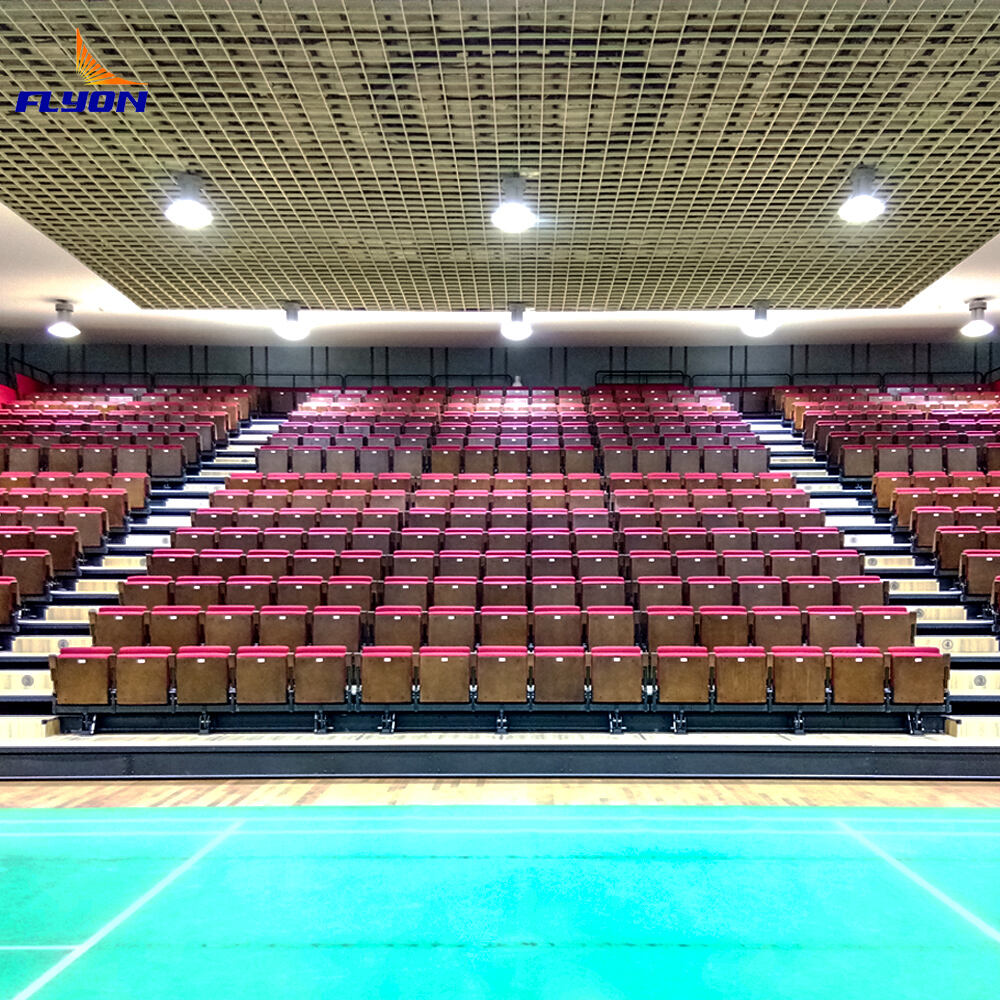The Strategic Role of Stadium Seats in Brand Identity
How Customizing Stadium Seats with Team Colors and Logos Strengthens Brand Recognition
Stadium seating has come a long way from just being places to sit during games. These days, seats often showcase team colors, logos, and special designs that match the overall look of the venue. The result? Fans get wrapped up in the atmosphere without even realizing it. Seats aren't just for sitting anymore but serve as constant reminders of the team spirit throughout the game day experience. According to some recent studies, around three out of four fans remember the branding better when the seats themselves display team symbols. That's pretty impressive considering how many other things are going on at a live sporting event.
Linking Venue Identity to Fan Loyalty Through Seating Design
When stadiums keep their branding consistent throughout seating areas, it actually creates a sense of ownership in the people sitting there. Research shows fans who sit in sections where chairs match team colors come back 22% more often than those in plain old seating arrangements. Why does this happen? Well, there's something about seeing your favorite colors and logos around you that makes folks feel part of the crowd. It taps into that primal need we have to belong somewhere. For arenas fighting for attention in crowded sports and entertainment scenes, getting this right can make all the difference between just another game day and building real fan loyalty over time.
The Impact of Color Schemes in Seating Design on Spatial Perception
How colors are used strategically can really change how people feel about a space and what kind of energy they sense there. When venues paint seats darker colors in those lower bowl areas near the action, it actually helps create a more intimate atmosphere where fans naturally focus on the game happening right below them. Meanwhile, the upper parts of stadiums often use gradual color transitions from one section to another, which somehow makes the whole place look deeper than it really is. Some sports arenas have started painting different seating areas with distinct colors, and interestingly enough, studies show this approach cuts down on crowd movement time by around 19%. People just seem to pick up on these color cues subconsciously, linking certain shades to where restrooms might be or which gates lead to parking lots.
Data Insight: 78% of Fans Report Stronger Emotional Connection When Seating Reflects Team Identity
A recent behavioral study of 12 major stadiums revealed fans in branded seating areas exhibited:
- 31% longer dwell times post-event
- 23% higher merchandise purchase intent
- 17% increase in social media check-ins
This emotional leverage converts transient attendees into brand ambassadors, creating viral-worthy visual backdrops that extend the venue’s digital reach.
Design and Customization: Integrating Branding into Stadium Seats
Integration of Logos in Stadium Seats for Maximum Brand Visibility
When teams put their logos in just the right spots around stadium seating areas, those seats basically become walking billboards for the brand all day long. Putting team emblems on things like seat backs, armrests even cup holder spaces creates these little visual anchors that people notice whether they're watching live or seeing game footage later. According to some research from last year's Venue Design Survey, places where logos are built into the actual seating have seen about 40 percent more mentions on social media during games than when there's no branding at all. Makes sense really because fans tend to take pictures of their seats anyway.
Materials and Techniques Enabling Durable Logo Integration in Stadium Seats
High-density polyethylene seats with UV-resistant coatings maintain logo clarity for 10+ years under direct sunlight. Manufacturers utilize dye-sublimation printing to embed logos at 3000 psi pressure, ensuring designs withstand 500+ lbs of force without cracking. Weather-resistant fabrics with antimicrobial properties prevent color fading in outdoor venues, complying with ISO 9001 durability standards.
Balancing Aesthetic Appeal of Custom-Colored Seats with Functional Design
While bold team colors enhance visual cohesion, seat ergonomics remain critical. Leading manufacturers employ 3D-molded foam with pressure-distribution mapping, allowing vibrant hues to coexist with 8-hour comfort ratings. A 2024 Fan Experience Report revealed 82% of attendees prioritize lumbar support over seat color, underscoring the need for design equilibrium.
Case Study: Iconic NFL Stadium’s Seat Customization Boosting Team Branding
A 65,000-seat NFL stadium demonstrated the power of integrated branding by embroidering team logos on every chair using abrasion-resistant polyester thread. Post-installation metrics showed a 28% increase in merchandise sales tied to seat-design elements and a 19% rise in season ticket renewals—proof that intentional customization drives measurable fan engagement.
Enhancing Fan Experience Through Branded Seating
Fan Engagement Through Branded Seating as a Driver of Immersive Experience
Modern stadium seats transcend functional roles by serving as dynamic branding canvases. When team colors and logos dominate seating layouts, they create an immersive visual landscape that amplifies fan engagement. This uniformity fosters a sense of collective identity, transforming spectators into active participants.
The Connection Between Fan Experience and Viewing Comfort in Modern Stadium Seating Designs
Ergonomic seating design correlates directly with prolonged fan retention. Stadium seats that prioritize lumbar support, heat dissipation, and unobstructed sightlines enhance comfort during multi-hour events. A 2023 Sports Facilities Survey found venues with ergonomic seating reported a 34% increase in repeat attendance compared to standard designs.
Controversy Analysis: Aesthetic Prioritization vs. Seating Ergonomics in Customization
While bold branding elements elevate visual cohesion, debates persist about sacrificing comfort for aesthetics. Overly rigid materials or intrusive logo placements can compromise seating ergonomics. However, innovations like pressure-molded team insignias and breathable fabric hybrids demonstrate that functional durability and brand expression are not mutually exclusive.
Achieving Visual Cohesion with Color Strategy
Color strategy transforms stadium seats from functional furniture into powerful branding tools that unify large venues.
Strategies for Achieving Cohesion Through Color in Large-Scale Seating Layouts
When designing stadiums, architects often use gradients and color zones to make those massive seating areas look cohesive. Teams want their colors to stand out throughout the venue, so designers repeat the main hues at regular spots around the stands. This helps fans recognize their team's presence without making it hard to see the game. Some recent research from 2024 suggests that when arenas stick to three main colors instead of going all one shade, people report feeling less overwhelmed visually. The numbers? Something like a 60-odd percent drop in complaints about too much going on visually compared to places painted just one color top to bottom.
Psychology of Color in Stadium Environments: Influencing Fan Energy and Perception
Red-dominated sections measurably increase spectator pulse rates by 8–12% during games, while blue-tinted areas show 15% higher concession spending due to calming effects. Teams leverage these biological responses strategically—placing visiting team fans in green zones (associated with passivity) and student sections in high-energy orange clusters.
Trend Report: Gradient Patterns and Dynamic Color Zoning in Stadium Chairs
Modern stadiums now feature:
| Pattern Type | Implementation Example | Branding Benefit |
|---|---|---|
| Horizontal Gradients | Transition from dark to light tones | Enhances perceived stadium depth |
| Chevron Zoning | Alternating color rows | Creates motion illusion on TV |
| Emblem Clustering | Seat-colored team logos | Reinforces identity from aerial views |
Industry Paradox: Uniform Branding vs. Section-Specific Identity in Seating Zones
While 73% of venues maintain primary brand colors across 80% of seats (Global Venue Report 2023), many now designate "identity zones" with localized color stories. This hybrid approach lets corporate boxes display sponsor colors while general seating maintains team allegiance—a compromise preserving both revenue streams and fan nostalgia.
Innovations in Stadium Seating: Where Aesthetics Meet Technology

Advancements in customization and aesthetic design of seating for visual impact
Stadium seating these days relies on modular building methods so sports arenas can create different colored sections without compromising the overall structure. These seats are made from UV resistant polymer blends that keep team colors looking fresh for years. Most manufacturers report around 98.5% color accuracy after a decade of exposure (according to the Stadium Materials Report published last year). The new materials also let designers incorporate striking geometric designs that look great in photos taken by fans sitting in the stands. Plus, these patterns help ensure logos and branding stay visible from all camera angles during broadcasts, which matters a lot for television coverage.
Smart seats with color-changing capabilities: The future of stadium branding?
New stadium seats with electrochromic tech are starting to appear across sports venues. These seats have tiny LEDs built right into them that can change colors on the fly during games, making the whole crowd area light up in sync with what's happening on the field. According to a recent survey from 2023, around two thirds of stadiums looking at renovations want to install this kind of system because it does two things at once: makes fans feel more connected to the action and turns empty seats into giant digital billboards when there's no game going on. The catch? People who've already tried installing these systems say they struggle with how much power they actually consume. One venue reported using about 23 kilowatt hours just for every hundred seats whenever they activate the color changes, which isn't exactly ideal if a stadium wants to cut down on its environmental impact.
FAQs
Why is customizing stadium seating important for brand identity?
Customizing stadium seats with team colors and logos strengthens brand recognition and creates an immersive fan experience that enhances emotional connection with the brand.
How do color schemes in stadium seating influence fan perception?
Strategic color schemes can impact spatial perception and fan energy levels, creating a more vibrant and engaging atmosphere that contributes to fan loyalty.
What technologies are being used in modern stadium seating designs?
Modern stadiums are incorporating materials like high-density polyethylene with UV-resistant coatings and smart seats with electrochromic technology to maintain aesthetic appeal and enhance fan engagement.
How can stadium seating design improve fan retention?
Ergonomic stadium seating featuring lumbar support and heat dissipation remain crucial in retaining fans during long events, leading to increased repeat attendance.
What are the environmental considerations for smart stadium seats?
While the innovative lighting technology enhances fan experience, it poses challenges in power consumption, impacting efforts towards reducing a venue's environmental footprint.
Table of Contents
-
The Strategic Role of Stadium Seats in Brand Identity
- How Customizing Stadium Seats with Team Colors and Logos Strengthens Brand Recognition
- Linking Venue Identity to Fan Loyalty Through Seating Design
- The Impact of Color Schemes in Seating Design on Spatial Perception
- Data Insight: 78% of Fans Report Stronger Emotional Connection When Seating Reflects Team Identity
- Design and Customization: Integrating Branding into Stadium Seats
- Enhancing Fan Experience Through Branded Seating
-
Achieving Visual Cohesion with Color Strategy
- Strategies for Achieving Cohesion Through Color in Large-Scale Seating Layouts
- Psychology of Color in Stadium Environments: Influencing Fan Energy and Perception
- Trend Report: Gradient Patterns and Dynamic Color Zoning in Stadium Chairs
- Industry Paradox: Uniform Branding vs. Section-Specific Identity in Seating Zones
- Innovations in Stadium Seating: Where Aesthetics Meet Technology
-
FAQs
- Why is customizing stadium seating important for brand identity?
- How do color schemes in stadium seating influence fan perception?
- What technologies are being used in modern stadium seating designs?
- How can stadium seating design improve fan retention?
- What are the environmental considerations for smart stadium seats?
 EN
EN
 AR
AR
 FR
FR
 PT
PT
 RU
RU
 ES
ES
 BG
BG
 HR
HR
 CS
CS
 DA
DA
 NL
NL
 FI
FI
 DE
DE
 EL
EL
 HI
HI
 IT
IT
 JA
JA
 KO
KO
 NO
NO
 PL
PL
 RO
RO
 SV
SV
 CA
CA
 TL
TL
 ID
ID
 SR
SR
 SK
SK
 UK
UK
 VI
VI
 HU
HU
 TH
TH
 TR
TR
 MS
MS
 AZ
AZ
 KA
KA
 BN
BN
 LO
LO
 MN
MN
 MY
MY
 UZ
UZ


